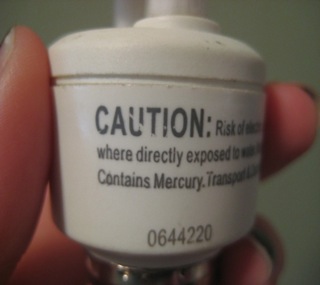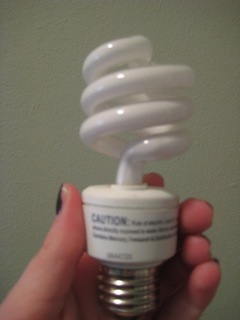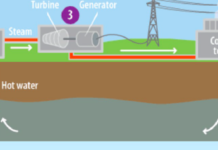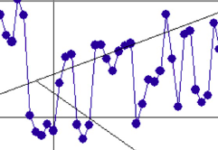Compact Fluorescent Light bulbs, known as CFLs, are famous for saving energy and lowering electric bills. However, they can negatively affect the environment and humans. Pretty ironic? So what makes this “green” appliance so bad? And what can we do to prevent it?
and lowering electric bills. However, they can negatively affect the environment and humans. Pretty ironic? So what makes this “green” appliance so bad? And what can we do to prevent it?
CFLs are the “swirly” bulbs that run on 13 to 25 watts of energy, which is less than the equivalently bright incandescent bulbs that are 60 to 100 watts. However, CFLs can harm the environment and humans because they contain toxic mercury.
In 2010, the National Electrical and Medical Imaging Equipment Manufacturers Association (NEMA), which is the trade association for electrical manufacturing industries, publicized a commitment for manufacturers to lower the amount of mercury in one 25 watt CFL from 5 to 4 milligrams. Companies that have committed so far include GE Lighting, Philips Lighting, and Halco Lighting Technologies. The U.S. Environmental Protection Agency (EPA) and U.S. Department of Energy say that CFLs mercury content has dropped at least 20% in the past years, and some manufacturers are even lowering the amount of mercury to 1 milligram.
Ed Hammer, a retired General Electric engineer and the inventor, developed these bulbs as an effective way to save energy when the U.S. had an energy crisis during the 1970’s. Since then, CFLs have become very popular because they save energy, money, and last longer than the normal incandescent bulbs. According to Gary Bertram, who works in the Air and Waste Management Division for EPA Region 7 in Kansas City, KS, “272 million CFLs sold in 2009”.
EPA says that these bulbs contain an average of 4 mg of mercury per bulb. This mercury is crucial in these bulbs because it provides an “efficient light source”. NEMA explains that CFLs contain a phosphor covered glass tube filled with mercury vapor, which is shot by a volt that energizes the mercury vapor to give off ultraviolet energy. The phosphor takes in the UV energy and shines with the fluorescent light.
Bertram comments, “If all 272 million CFLs sold in 2009 were sent to a landfill (versus recycled, as a worst case)–they would add 0.12 metric tons, or 0.12%, to U.S. mercury emissions caused by humans. If repeated for 10 years, this could result in approximately 1.2 metric tons of mercury entering the environment as a result of CFL disposal." On the other hand, GE Lighting says that coal-fired power plants result in about 40% of U.S. mercury emissions.
(versus recycled, as a worst case)–they would add 0.12 metric tons, or 0.12%, to U.S. mercury emissions caused by humans. If repeated for 10 years, this could result in approximately 1.2 metric tons of mercury entering the environment as a result of CFL disposal." On the other hand, GE Lighting says that coal-fired power plants result in about 40% of U.S. mercury emissions.
The EPA believes that not enough has been done to get people to dispose of CFLs correctly. Home Depot tells SciJourner that their stores have a recycling area to dispose of CFLs. In contrast, Lowe’s employees were unsure if they had any sort of recycling area; some didn’t even know what CFLs were!
A recent survey of 85 people found that 71% recycle waste, but only 42% knew that CFLs need to be recycled, even after being informed that they contained mercury. This survey had a variety of people: high school students, teachers, and other adults.
Marijn Braadbaart, an energy engineer at Ross & Baruzzini, an Architectural/Engineering company in Webster Groves, MO, clarifies that if CFLs are thrown away in the trash, the mercury may end up in landfills. This mercury increases the toxicity of the landfills, and if not carefully maintained, can increase the risk of toxicity in our groundwater supply.
Mercury in our groundwater supply could potentially be harmful. Mercury is a neurotoxin, which can harm the brain and nervous system. Studies have also shown that neurotoxins are connected to children with lower IQs.
Bertram explains, “Exposure to elemental mercury may result in tremors; emotional changes; insomnia; neuromuscular changes; headaches; disturbances in sensations; changes in nerve responses; performance deficits on tests of cognitive function. At higher exposures there may be kidney effects, respiratory failure and death." Bertram also mentions that mercury exposure in wildlife could result in a “reduced fertility, slower growth/development, abnormal behavior, and death.”
However, GE Lighting says CFLs avert mercury leaking into the environment because they lower the mercury emitted from coal-fired power plants that produce the electricity used for incandescent bulbs. However, coal-fired power plants will emit 13.6 milligrams of mercury powering a normal incandescent bulb, which is more than the amount of mercury in CFLs.
If a CFL breaks in your home, the EPA says to use duct tape to pick up the broken pieces, vacuum the area, and then clean the vacuum bag.
State government requirements offer more information. The Missouri Department of Natural Resources states that it is legal to throw away these bulbs in the trash in Missouri but, preferably enclosed in a zip lock bag. However, they advise buyers to recycle CFLs at retail stores or at household hazardous waste collection centers. However, only some centers accept these bulbs.

This work is licensed under a Creative Commons Attribution-NonCommercial-NoDerivs 3.0 Unported License














A very illuminating article– really!
Interesting article! You might enjoy this article from Scientific American’s website: http://www.scientificamerican.com/blog/post.cfm?id=a-better-kind-of-light-bulb-2011-03-21
I really liked your article, it was really interesting. I never knew that an appliance I use everyday can be harmful to the environment. My hope is that everyone will learn to dispose of CFL’s the right way.
This was a really interesting and informative article! Before reading this,I had no idea what CFLs were or the potential dangers they have, but now I do thanks to your article
enlightening article! i never knew that CFLs could be dangerous!
Great article! I did not know that something like CFLs that my family uses in my daily could be harmful to the environment. My hope is that people will learn to dispose of CFLs in the correct manner.
Great article! I did not know that something like CFLs that my family uses in my everyday life could be harmful to the environment. My hope is that people will learn to dispose of CFLs the correct way.
What a great article! I never realized how important this topic is!
It is very interesting to learn that CFLs, which are meant to conserve energy, can be harmful to human beings. While they conserve energy, the harmful effects of these light bulbs must be taken into account when choosing light bulbs for one’s home and work place. This article is very informative, and I did not know a great deal of this information until reading this article.
This was an interesting article because I never realized that CFLs could have a negative impact on the environment